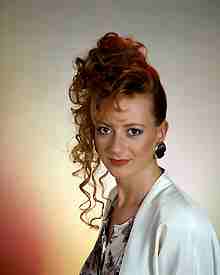Back to Front
As Ian Gee showed last month, a mid-grey background can be turned to almost
any colour simply by fitting filters over the light. The same principle
applies to product shots, and was used for the collection of low-cost flash
meters shown elsewhere in this month's studio section. It was also used
for the picture reproduced here, though in this case the background light,
which was also allowed to catch the model's hair, was fitted with a home-made
panelled filter that had red and yellow squares. The result is a variation
in colour across the plain paper background roll. Colouring backgrounds
is easy, but a few basic points must always be kept in mind.

- The first is that addition of coloured light can only make a background
lighter.
- The second is that, after a certain point, the colour becomes less
saturated as the brightness increases.
- The third is that spill from (white) foreground lighting de-saturates
the colour.
- The fourth, and last, is that filtered lights are reduced in intensity
p; quite dramatically in some cases.
A good method of working is to light the background first. By doing this,
the ruinous effect of poorly controlled foreground lighting is immediately
revealed. Keeping the main light close to the subject (and proportionally
far away from the background) helps to reduce spill, while fitting barn
doors, whether using a soft-box or a dish reflector, helps to improve control.
Best of all, use free-standing flags (pieces of black card) to shadow the
background from foreground lighting. As to the filters themselves, pre-cut
sets are available for most makes of flash monoblocs.
In the case of the Courtenay units used to light the collection of meters,
filters are secured to the barn doors' frame using magnetic strips. Elinchrom,
Bowens and other manufacturers also offer accessory sets that include filter
mounting frames. If no such system is available, filters can be taped to
the light p; but extreme care must be taken to guard against over-heating.
If in doubt, use only heat-resistant filter materials and switch off the
modelling lamp.
Lee Filters can provide suitable filter sheets at very low cost. Also from
Lee Filters, unveiled at Focus and advertised in Photon last month, is the
Wizard frame. This free-standing support can be used to position filters
in front of one or more lights, and can do so at a sufficient distance to
ensure adequate ventilation at all times. Watch out for a test report on
this very interesting accessory in a future column.
Return to Photon June 96 Contents
